Historical Notes
by Francesco Mariucci
We learn from a bull by Pope Alessandro IV that the church was already being used for worship in 1256. Was probably completed at the end of the century, when the first Franciscan pope Niccolò IV went up to the papal throne (Pope from 1288 until 1292), who in 1291 conceded indulgences to those who had contributed to the completion of the works of the church itself.
The main (west) facade is divided into three areas delimited by pilasters. The upper part is unfinished. It is probable that the primitive design had three round windows as it derives from the design of the interrupted masonry. The central rose window, installed only in 1958, comes from the church of S. Francesco in Foligno. The façades towards the Square 40 Martiri, or of the Market, are marked by single lancet pilasters with the exception of the small façade (north side) with double portal and the beautiful rose window.The bell tower built on the lower apse on the left was built in the XV century. The interior of the building has a three aisles scheme. The interior walls were completely covered by frescoed painting cycles, works that were submerged or cancelled in the radical transformation of the 18th century. The surviving medieval frescoes rediscovered in 1938 testify the splendour of the church between XIII and first of XV century .The so-called “Master of San Francesco di Gubbio”,(active between 1270 and 1280) decorates the basin of the central apse of the basilica andthe upper part of the right apse of the basilica.He is a painter follower of the great artists active in the basilica of Assisi before the advent of Giotto, that is before the realistic turning point of the Italian painting of the end of the XIII century. Between the second and third altar on the left (n. 2) there are some traces of frescoes made at the end of the thirteenth century by an artist fatally attracted by the revolutionary Giotto current as well demonstrated by the sculptural yields of the figures portrayed; it is a reflection of the extraordinary events taking place in the upper basilica of Assisi, the first capital of Italian art. Few years later (about 1320) another painter coming out from the great Assisi shipyards, the so-called "expressionist teacher of Santa Chiara" (Palmerino of Guido from Gubbio?) direct pupil of Giotto, frescoes the lower part of the right apse constituting the Sforzolini chapel.
The frescoes with the Marian stories of the left apse , youth masterpiece of the painter Ottaviano Martino Nelli, date back to the beginning of the fifteenth century (1410-1415). In support of the illustration, in addition to the canonical gospels, he drew largely from the apocryphal gospels and the "golden legend" of the Dominican Jacopo da Varazze (1228-1248).
But the most significant place of the whole church is constituted by the current sacristy, true "cella memoriae” that the constant Eugubina tradition, corroborated by the archaeological findings, indicates always as of the Spadalonga’s, house the rich family of merchants who offered a prompt welcome and the "poor tunic" to S. Francesco in the winter of 1206, after his aimless exodus from the town of Assisi to Gubbio. Because of this historical fact narrated by Fra Tommaso da Celano (+ 1260), the town of Gubbio proudly declares itself "the second city of S. Francesco”.

